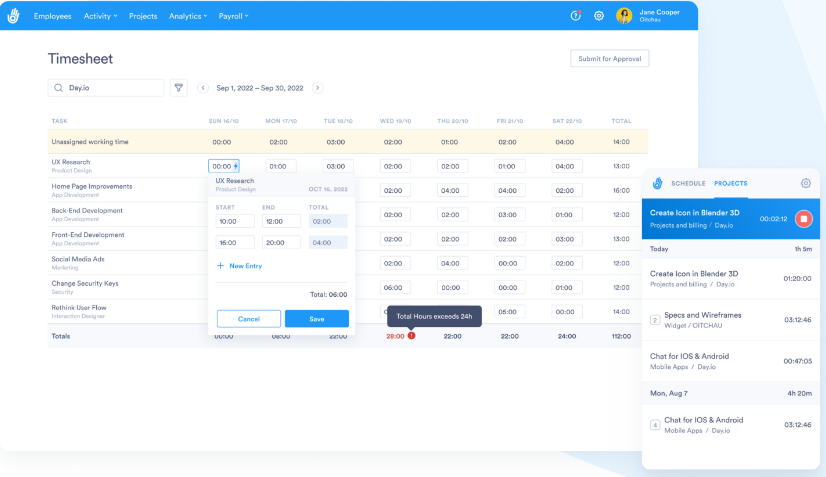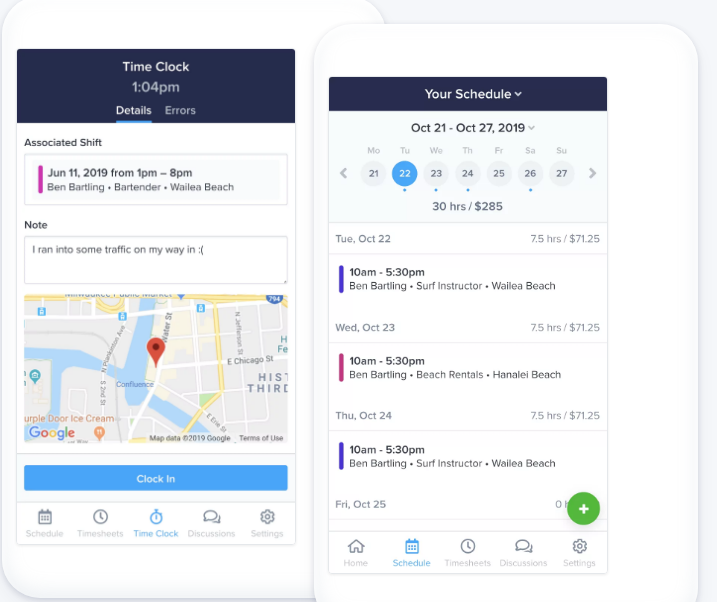Time is a finite resource we all share equally, but how we use it varies widely. One of the biggest challenges in today’s fast-paced world is finding the time to finish everything. With so many responsibilities, deadlines, and distractions, it’s easy to lose track of where our time goes.
This is where a weekly timesheet can help. You can make every minute count and increase productivity by tracking your time and prioritizing your tasks. In this article, we’ll dive into the benefits of using a weekly timesheet and how it can help you stay organized and focused.
We’ll also explore how to create one, the best practices to use it effectively, and the top tools and apps to help you get started. Whether you’re a busy professional, student, or entrepreneur, a weekly timesheet can be a game-changer for productivity. So let’s get started and unlock your full potential!
Throughout this article, we’ll discuss:
- What is a Weekly Timesheet?
- Why Use a Weekly Timesheet for Increased Productivity?
- How to Make A Weekly Timesheet?
- Best Practices to Use a Weekly Timesheet
- Features to Look for in Your Timesheet App
- Best Tools to Create Weekly Timesheet
- Wrap-up: Rev up Your Productivity with the Best Weekly Timesheet App

What is a Weekly Timesheet?
A weekly timesheet is a simple yet powerful tool for tracking your time and measuring productivity. It’s an organized way to record the hours you spend working on individual tasks or projects over seven days. This allows you to see exactly how much time you spend on each task and identify areas where you could be more efficient.
In addition to the weekly timesheet, you can create a monthly or bi-weekly timesheet. This allows you to track progress over a more extended period and compare your productivity from week to week.
Using a timesheet makes it easy to stay organized and prioritize essential tasks while minimizing distractions like checking your email or scrolling through social media. It also helps reduce stress by allowing you to focus on one task at a time instead of trying to juggle multiple projects.
Why Use a Weekly Timesheet for Increased Productivity?
A weekly timesheet offers many benefits that can help you maximize your productivity. Here are a few of the main advantages:
- Accurate understanding of time: One of the primary benefits of using a weekly timesheet is that it gives you an accurate picture of how much time you spend on each task. This can be beneficial if you want to identify areas to improve or reduce your time. With this information, you can prioritize tasks and make better decisions about where to focus your energy.
- Improved focus and organization: A weekly timesheet also helps keep you organized by keeping track of all your tasks in one place. You can easily see what needs to be done and when, which can help reduce stress levels while improving overall productivity.
- Prioritization of tasks: By tracking your time, it’s easier to prioritize tasks and determine which ones are most important. This can help you focus on the right tasks to maximize productivity and avoid wasting time on less-important projects.

- Reduced stress levels: Keeping track of your time also helps reduce stress levels by giving you a clear understanding of what needs to be done. This information makes it easier to plan and stay organized without feeling overwhelmed or stressed about upcoming deadlines.
- Increased productivity: A weekly timesheet allows you to measure the work completed over time. This can help you stay on track and motivated as your productivity levels increase.
- Improved quality of work: By tracking how much time is spent on each task, it’s easier to determine which tasks are most important and focus on them first. This allows you to produce higher-quality work while ensuring that deadlines are met with fewer mistakes or errors.
- Easier invoicing: For freelancers and independent contractors, a weekly timesheet can help streamline the invoicing process. By keeping track of time spent on each project, it’s easy to calculate how much you should be paid for your work.
- Optimizing resource allocation: Companies with multiple teams or employees can use a weekly timesheet to optimize resource allocation and keep better track of employee performance. This helps ensure that resources are used efficiently, and everyone is working towards the same goal.
How to Make A Weekly Timesheet?
A weekly timesheet is a simple spreadsheet or document that helps you track how you spend your time. Individuals and teams can use it to monitor employees’ working hours and manage their workloads. It is usually divided into days or weeks, with each row indicating a specific task, activity, or project.
The timesheet should also include the start and end times for each task and any breaks taken throughout the day. This helps you track how much time was spent on the task and if there were any delays or interruptions that might have caused it to take longer than expected.
There are several methods for creating a weekly timesheet, depending on the size of your team and the complexity of your tasks. Let’s take a look at some of the most popular methods.
1. Using Spreadsheets
One of the most conventional and popular ways to make a weekly timesheet is with a spreadsheet. Microsoft Excel or Google Sheets are the most widely used for this purpose, as they allow you to store data and manipulate it easily.
This method is great for teams that don’t need real-time tracking or advanced reporting features but still want an easy way to keep track of their time. You may typically include the following columns:
- Task Name
- Project or Activity
- Start Time
- End Time
- Break Hours
- Total Hours
You may also use formulas to automate calculations and get quick insights into the data. For example, you can use SUM formulas to add the total hours worked per day or week.

2. Timesheet Templates
If you don’t have the time or skills to create a timesheet from scratch, you can always use pre-made templates. These are available online and in office productivity software like Microsoft Word or Excel.
Templates can be great starting points for creating your own weekly timesheets. You can customize them according to your needs and add extra columns if necessary. They usually have built-in formulas so that calculations are made automatically when data is entered into the spreadsheet.
3. Automated Timesheet App
Finally, to maximize your efficiency, consider using an automated timesheet app. These apps can be used on computers and mobile devices and automate much of the data entry process for you. They also come with features such as time tracking, task assignment, reporting, project management, invoicing, and more.
Using an automated timesheet app is a great way to make sure that your weekly timesheets are always up-to-date and accurate. The best apps will have intuitive user interfaces so that it’s easy to use them from any device.
8 Features to Look for in Your Timesheet App
When choosing the best timesheet app for you, there are certain features to look out for. Here are some features to keep in mind:
1. Easy Interface
Ease of use is one of the main reasons why timesheet apps are so popular. Make sure you choose one that is easy to use with an intuitive and straightforward interface.
A graphical user interface will allow you to enter data quickly and understand the information presented. A good timesheet app should also have customizable settings and options so that you can tailor it to your specific needs.
2. Automated Time Tracking
Manually tracking and entering your time is a tedious and laborious process. Automated time-tracking allows you to monitor your activities without any manual effort easily.
Look for an app that provides automated time-tracking features, including geolocation, face recognition, voice commands, and more. This will save you from manually entering each task or project into the timesheet app every day.
3. Configurable Reporting based on Timesheet Data
Having access to detailed reporting is essential for any timesheet app. It allows you to analyze how much time you’ve spent on each task or project, identify areas of improvement, and make better decisions.
By customizing your time reports, you can get more granular data that will help you improve your workflow and track progress on any project. You can also gain valuable insights into how you spend your time and make more informed decisions.

4. Collaboration Tools for Teams and Clients
Hybrid working and remote working have increased the need for collaboration tools. A good timesheet app should include features that allow teams to collaborate and work together and keep track of client tasks.
Look for an app with project management capabilities, real-time chat support, shared task lists, and file-sharing options. This will make it easier for you to stay on top of projects and provide clients with timely updates.
5. Integration with Other Apps & Services
You don’t want to juggle multiple apps and services for time tracking. An excellent weekly timesheet app should be able to integrate with other services, such as project management apps, calendar apps, and more.
This will help you sync data between the different apps and have a unified view of your activities. It will also save time that would otherwise be spent on manually entering data into multiple systems.
6. Data Security & Privacy Protection
Timesheet apps can help you stay organized and store sensitive data about your activities and finances. Ensure that your timesheet app has robust security measures to protect this data.
For instance, GDPR compliance, biometric authentication, and encryption ensure your data is secure and private. Online user reviews and reputations will give you an idea of the company’s commitment to data security.
7. Mobile App Accessibility
Most timesheet apps are available on desktop and mobile devices. This allows you to access your data from anywhere, anytime. Offline access is also vital in case you don’t have internet access needed.
Mobile apps often include GPS tracking and geolocation to record your location when working efficiently. This can help to monitor employee activities, verify time entries, and ensure accuracy in timesheet data entry.

8. Invoice and Billing
Lastly, invoicing and billing options are essential for freelancers, contractors, and businesses that bill clients hourly. A good timesheet app should allow you to generate invoices from your data quickly and easily. This is especially helpful if you charge clients by the hour as it helps track time accurately and avoid overcharging or undercharging.
Many timesheet apps may also allow you to schedule automatic billing and invoicing. This helps to ensure timely payments and reduces the time spent on manual tasks such as recording timesheet data, invoice preparation, and payment tracking.
Best Practices to Use a Weekly Timesheet App
Using a weekly timesheet isn’t just about tracking your time; it’s also about setting goals and staying focused. Here are some best practices for using a timesheet to increase productivity:
- Set realistic, measurable goals and break them down into smaller tasks. This will help you manage your workload more effectively.
- Track the amount of time spent on each task and how productive you were during that period. This will help you understand better how much effort is required to complete certain activities.
- Prioritize tasks according to individual urgency so that you can focus on what’s most important first.
- Take regular breaks throughout the day to allow your brain to rest and recharge.
- Schedule time for yourself each week, so you can relax, have fun, and stay motivated.
- Track progress over time by setting milestones and measuring your results. This will help you see where you’re progressing and areas that need improvement.
- Use automation tools to save time and reduce manual effort.
- Communicate the importance of time tracking to your team and set up a system for everyone to follow.
By following these best practices, you can maximize the benefits of using a weekly timesheet and ensure every minute counts.
Best Tools to Create Weekly Timesheet
When creating a weekly timesheet, many options are available. We’ve researched the top tools and apps to help you find the best one for your needs. Here are some of the leading solutions:
1. Day.io – Best Overall Weekly Timesheet App with Strong Project Tracking Capabilities

Day.io comes with comprehensive time tracking and project management capabilities that make it the best overall weekly timesheet app. It offers an intuitive user interface with a simple drag-and-drop workflow and real-time updates to stay organized and productive.
The app also includes powerful features like project tracking, invoicing, expense tracking, reporting, etc. Day.io is easy to use for both individuals and teams of any size. It works on all major platforms (iOS/Android/Windows), including mobile devices, so you can track your time from anywhere!
Features
- Time tracking with automated task progress tracking
- Weekly timesheet builder with plenty of customizations for reporting
- Time reports with extensive details on tasks, clients, and projects
- Insightful project analytics to stay on top of the task list
- Powerful invoicing and expense tracking features
- Integration with many popular third-party applications
- Employee schedule planner to keep everyone on track
Pricing
- Project time tracking: $6 per user/month
- Time and attendance tracking: $4 per user/month
2. ClickTime – Excellent Timesheet App for Mobile Devices

ClickTime is an excellent timesheet app for mobile devices. It has a simple and intuitive design making tracking your time on the go easy. The app also offers powerful features like project tracking, invoicing, expense tracking, reporting, etc.
It’s perfect for individuals and teams of any size who need to track their time from anywhere. In addition to the weekly timesheet, you can easily prepare expense reports and invoices.
Features
- Intuitive mobile timesheet app with a simple and user-friendly interface
- Easily track time while on the go with the help of geolocation features
- Detailed reporting to monitor the progress of individual tasks or projects
- Integration with popular business applications like Salesforce, QuickBooks, and more
- Robust budgeting tools to keep your projects within budget
Pricing
- Starter: $10 per user/month
- Team: $13 per user/month
- Premier: $24 per user/month
3. ZoomShift – Online Timesheet App with Many Essential Features

ZoomShift is an online timesheet app with many essential features. The app’s graphical dashboard makes it easy to view your team’s time and projects in one place. It also offers powerful features like project tracking, invoicing, expense tracking, reporting, etc.
The drag-and-drop scheduler builder makes it easy to create and edit schedules. ZoomShift also allows you to easily track your time from any device, which is a great way to stay productive when you’re on the go.
Features
- Comprehensive online timesheet builder with plenty of customization options
- Time tracking for individual tasks or projects to monitor progress
- Automatic reminders and notifications to keep everyone on track
- Integration with popular tools like Slack, Jira, and Trello
- Robust payroll system to manage employee payments easily
- Insightful analytics to identify areas of improvement in time management
Pricing
- Starter: $2 per user/month
- Premium: $4 per user/month

Wrap-up: Rev up Your Productivity with the Best Weekly Timesheet App
Whether you’re a busy professional, student, or entrepreneur, tracking your time with a timesheet is essential to unlocking your full potential. When choosing the best weekly timesheet app for your needs, consider features like project tracking capabilities, mobile support, essential features like time tracking, reporting tools, and more.
With the right app, you can rev up your productivity and maximize your week. Day.io is a top weekly timesheet app with strong project-tracking capabilities. If you’re looking for a solid, all-around weekly timesheet app, try Day.io today!
